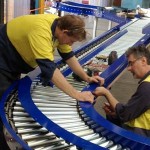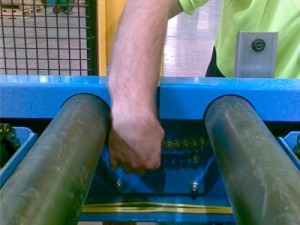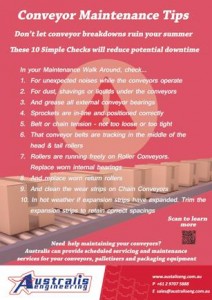Summer time means hot weather, holidays, cold drinks and ice-cream, barbecues and entertaining. For many food, beverage or general manufacturers, summer is often prime time for getting their product to market. Unexpected downtime can be disastrous, resulting in lost production, lost profits and an inability to meet supply obligations. While many producers automatically have scheduled maintenance programmes for their critical capital equipment like fillers, packers, labellers, packaging equipment and robots, they often over look the “glue” of any modern production facility – the conveyors. Yet simple preventative maintenance can reduce the risk of downtime. Click on the heading to discover 10 simple steps to conveyor maintenance.
10 simple steps to minimise conveyor downtime
Having any equipment fail during peak production periods will cause some serious stress. Over the summer period, any downtime can be further exacerbated by slow response times for spare parts as suppliers are closed for the holidays or have longer lead times to source key components. A little preventative maintenance on your conveyor systems will therefore go a long way to helping avoid unexpected downtime.
Conveyors are integral to the operation of most manufacturing facilities and quite often the facility will utilise a range of different conveyor types, from simple roller and belt conveyors, to slat chain, modular belt, chain, bucket or even air conveyors. Regardless of the mix of conveyors in use, there are some simple steps that your team can implement to reduce the risk of conveyor break downs and so reduce your downtime.
Firstly we strongly suggest a daily walk around where you “look and listen” to the conveyors running. With this in mind, we suggest you:
- Check for any unusual or unexpected noises while the conveyor is operating. This might indicate parts are rubbing against each other or under too much load
- Check for any metal or plastic shavings, dust or liquids (eg oil) under the conveyors which may suggest parts are wearing unexpectedly or leaking
- As a preventative step, regularly grease all external conveyor bearings to ensure they are running smoothly
- Check that the external sprockets are all in-line and tightened correctly
- Test the belt or chain tension on your belt or chain conveyors. Do not over tension belts and chains as this will lead to breakages or more result in rapid wear of the head and tail rollers/ sprockets. Similarly if the chains or belt are too loose, you may have inconsistent wear or poor performance from the conveyor
- Check that the conveyor belting is tracking in the middle of the head and tail rollers on your belt conveyors (see images below)
- Test that the rollers on your Roller Conveyors or Pallet Conveyors are running smoothly. If rollers are not spinning freely, check the roller bearings and replace where possible
- Inspect for any high wear on return rollers. Return rollers should be consider a consumable item, so replace if high wear is evident
- Regularly clean the wear strips on any Chain Conveyors
- In hot weather if expansion strips have expanded too far and are rubbing, it may be necessary trim some of the expansion strip to retain the correct spacings
Finally, we also suggest you keep a daily log of any issues that you might find so that minor problems can be tracked over time and that scheduled servicing can focus on any issues.
Download our free Conveyor Maintenance Poster
Want to ensure your staff keep these 10 Simple Conveyor Maintenance Tips front of mind? Download our Conveyor Maintenance poster that summarises the key points identified above.
Print the poster and place it in your Lunch Room or Operations Area to ensure you never forget these 10 simple steps to conveyor maintenance.
Scheduled maintenance programmes
These 10 simple steps are by no means a comprehensive conveyor maintenance programme. However they are suggested as a basic preventative check that will enable your team to quickly identify any areas of concern and take steps to head off an unexpected break down. While these 10 simple steps are great first step at avoiding an untimely breakdown, they will not replace a systematic servicing and maintenance programme. With over 36 years of conveyor manufacturing, installation and commissioning experience, Australis can recommend a scheduled servicing and maintenance programme for your conveyor systems and we can even provide our expert tradespeople to conduct the programme.
Is the conveyor safe?
We shouldn’t leave the topic of conveyor maintenance without a short mention about safety. While an unsafe conveyor may not stop working, having one of your staff become injured due to an unsafe conveyor is likely to result in unexpected and unwanted disruption to your production – and most importantly causing injury to your personnel is something to be avoided at all costs!
To ensure your conveyors are safe:
- When conducting servicing or maintenance, DO NOT rely on the E-stop to turn off the conveyor. Switch off the conveyor at the motor, control panel or similar.
- Check that following any maintenance, all machine guards are re-installed, engaged and intact
- Inspect to ensure that pinch points have not developed (due to conveyors being relocated or components being removed)
- Check that infill plates have been reinstalled (especially on chain conveyors)
- Validate that E-stops or Light-Curtains are engaged and operating correctly








